
Reading & Resources
School Administrator, August 2020
Book Reviews
 EdSpeak and Doubletalk: A Glossary to Decipher Hypocrisy and Save Public Schooling
EdSpeak and Doubletalk: A Glossary to Decipher Hypocrisy and Save Public Schooling
by Diane Ravitch and Nancy E. Bailey, Teachers College Press, New York, N.Y., 2020, 167 pp with index, $29.95 softcover, $90 hardcover
In
EdSpeak and Doubletalk: A Glossary to Decipher Hypocrisy and Save Public Schooling, Diane Ravitch partners with Nancy E. Bailey to create a guide focused on clarifying the many terms and concepts relating to public schools in the United States.
Ravitch, a research professor of education at New York University, was formerly the Assistant Secretary of Education in the administration of President George H.W. Bush. Bailey is a longtime K-12 public school teacher in special education and has published multiple books and articles.
Ravitch’s 2006
EdSpeak originally set out “to demystify education vocabulary so that every parent and citizen could understand the language of professionals.” This updated version of the book not only helps clarify the many terms used daily in educational settings, it also provides a clear look into the intersection of politics and public schools.
In 27 chapters, the book covers every topic or term connected to education that anyone could imagine. Multiple chapters are dedicated to the ongoing attempts and organizations who continue to push to privatize the public school system in the United States. Not only are the organizations pushing this agenda identified, but the historical origin of each group and how they network with other organizations toward their goal is effectively described in these chapters.
The format is unique, providing background on thousands of topics in one short book. For example, chapter 11, “School Reform Groups and Terms, or Money Talks” describes 63 different topics in only 22 pages.
I found the book to be very helpful and informative. This book could be utilized across any superintendent’s school district to provide all stakeholders a clear and succinct overview of many terms and concepts.
Reviewed by Justin B. Henry, superintendent, Goddard, Kan.
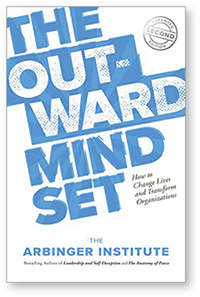
The Outward Mindset: How to Change Lives and Transform Organizations
by Arbinger Institute, Barrett-Koehler Publishers, Williston, Vt., 2019, 187 pp., $17.95 softcover
We see people, problems and organizations far better with an ”outward mindset.” This book, The Outward Mindset: How to Change Lives and Transform Organizations (second edition), by the Arbinger Institute, provides many stories to make that point. This is the third book in a series that includes Leadership and Self-Deception and The Anatomy of Peace.
An inward mindset causes us to see people as objects. We may drive hard for goals, outcomes or the bottom line. But with an inward mindset it is hard to see clearly the interests, needs and motivations of the very people needed to make those goals and outcomes a reality.
The outward mindset starts by seeing the people and their needs. In doing so, we are better able to partner around shared work that better delivers the outcomes we strive for. And when we internalize this way of being — truly seeing the hopes and dreams and needs of our colleagues — others in our organizations begin to follow our lead.
This is a great book for everyone in our schools, from the board room to the classroom. Although it best applies to school and district leaders, teachers will also see application to improved working relationships with their students.
I hear often from colleagues how hard it is to make cultural shifts in schools — to get entire organizations on board for improved student learning. The Outward Mindset provides multiple examples of organization turnarounds. This quick and easy read provides many positive starting points for engaging our teams in new and productive ways.
Reviewed by Larry L. Nyland, retired superintendent, Seattle, Wash.
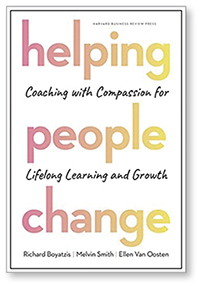 Helping People Change: Coaching with Compassion for Lifelong Learning and Growth
Helping People Change: Coaching with Compassion for Lifelong Learning and Growth
by Richard Boyatzis, Melvin L. Smith, and Ellen Van Oosten, Harvard Business Review Press, Boston, Mass., 2019, 244 pp., $30 hardcover
Helping People Change: Coaching with Compassion for Lifelong Learning and Growth, by Richard Boyatzis, Melvin Smith and Ellen Van Oosten, is both an argument for a more thoughtful process to stimulating change and a step-by-step handbook for learning and applying the coaching plan.
Boyatzis is a professor at Case Western Reserve University. Smith and Van Oosten are faculty directors of executive education at the university’s Weatherhead School of Management.
They have applied their coaching method in many settings including medicine, business, and schools. The book cites case studies and verified research as evidence of the effectiveness of the process. Coaching with compassion is a more life-changing process than coaching for compliance. It is grounded in the idea that people can change when they want to change. Coaching with compassion helps individuals discover their own motivations and leads to commitment to developing their fullest talents.
Rather than focus on ”fixing” people to correct problems, the authors provide a process that helps people find a positive vision of themselves that sustains efforts to change even through difficult times.
This is a book for school leaders who are serious about building a culture where everyone thrives — principals, teachers, students, even parents and central office staff. The concrete strategies outlined in the book and the specific exercises for individuals to undertake to develop their skills make this text more than something to just read through. Mastery of the content will change individuals and schools.
Imagine a school where students know how to build the futures they want, a school where staff and students are partners in constructing fulfilling lives.
The authors of this book make great promises to those who will follow their lead. They have proved their method of coaching works. School staffs who seriously apply the effort needed to become compassionate coaches will find their quest rewarding.
Reviewed by John C. Fagan, retired superintendent, Oak Park, Ill.
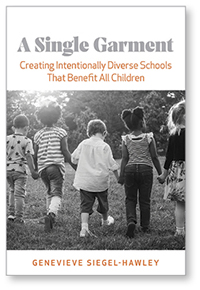
A Single Garment: Creating Intentionally Diverse Schools That Benefit All Children
by Genevieve Siegel-Hawley, Harvard Education Press, Cambridge, Mass., 2020, 272 pages, $33 softcover.
Genevieve Siegel-Hawley begins A Single Garment: Creating Intentionally Diverse Schools That Benefit All Children with a letter to her preschool daughter, Posey, written just before the 2016 election. Her letter quotes Martin Luther King Jr.’s “Letter from a Birmingham Jail” in which Dr. King wrote, “Injustice anywhere is a threat to justice everywhere. We are caught in an inescapable network of mutuality tied in a single garment of destiny.”
Siegel-Hawley, an associate professor at Virginia Commonwealth University, details research that documents the improved academic and social benefits to all students in a diverse integrated school setting. She has chosen to have her own daughter, who is white, attend public school in Richmond, Virginia. Ironically, Richmond was the first district to enshrine segregation in law for local schools in 1902 and has been in a long and ongoing struggle over integrated and segregated school opportunities.
A Single Garment provides detailed analyses of K-12 education being analyzed in this study. Siegel-Hawley not only cites the research, but also includes clear descriptions of key teacher, parent, and educational leaders at each school with anecdotes about the environment in each school community. She provides enough detail to illustrate that program, curriculum and school culture decisions align with best practices.
There are a variety of systems in place at one or all of the schools, including free transportation, racially diverse faculty, higher order thinking skills, social and emotional learning, and transformational leadership. Siegel-Hawley wrote, “All of our schools focused on making strong connection between students’ home and educational lives.”
The letter to her daughter closes with another familiar quote by Dr. King, who said, “The arc of the moral universe is long, but it bends toward justice.” Siegel-Hawley agrees, but adds, “I sure do wish it would bend a little faster sometimes.”
Reviewed by Bob Schultz, retired superintendent, Davis, Calif.
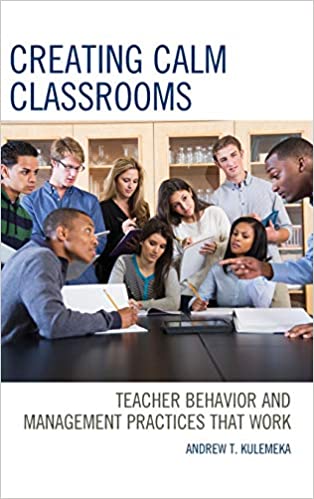
Creating Calm Classrooms: Teacher Behavior and Management Practices That Work
by Andrew T. Kulemeka, Rowman and Littlefield, Lanham, Md., 2019, 81 pp.,$25 softcover
Creating Calm Classrooms: Teacher Behavior and Management Practices that Work by Andrew T. Kulemeka is a comfortable read. Kulemeka writes in a style that is jargon free, fluid and practical for an audience of novice through veteran educators.
Kulemeka includes realistic scenarios. For some readers, they may be an eye opener and for others a reminder or food for thought. Preparation is key, and this is restated throughout the text in different ways to show the impact upon teachers and students. Administrators could use the scenarios in this book during observations and evaluation conversations.
As an administrator, I found this book could be useful for preparing staff for the new school year. It is also relevant to helping to refocus staff who may be having classroom or parent challenges. The book outlines strategies independent of content areas, so staff across departments and grade levels could discuss it with equal participation and reflection opportunities.
Creating Calm Classrooms: Teacher Behavior and Management Practices That Work will give staff reminders about the importance of pausing for reflection and discussion.
Reviewed by Hope S. Blecher, educational consultant, Dumont, N.J.
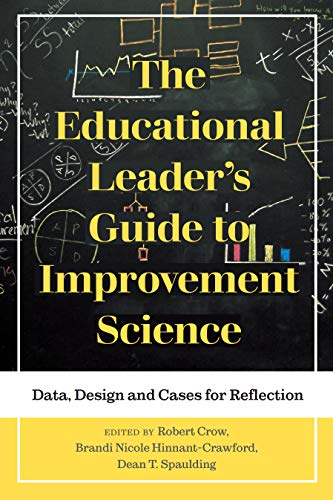 The Educational Leader’s Guide to Improvement Science: Data, Design and Cases for Reflection
The Educational Leader’s Guide to Improvement Science: Data, Design and Cases for Reflection
edited by Robert Crow, Brandi Nicole Hinnant-Crawford and Dean T. Spaulding, Myers Education Press, Gorman, Maine, 2019, 339 pp., $42.95 softcover, $149.95 hardcover
The Educational Leader’s Guide to Improvement Science: Data, Design and Cases for Reflection, edited by Robert Crow, Brandi Nicole Hinnant-Crawford and Dean T. Spaulding, will provide an indispensable resource for practitioners and researchers as they address the effective utilization of data to guide their improvement science initiatives.
Educators spend a great deal of time having to think about and justify their actions related to continuous improvement initiatives within their programs and district. Often, these introspective investigations occur without the theoretical or foundational supports necessary to help guide these inquiries, leaving the participants grappling at artifacts and data, with no cohesive way to utilize that content for continuous improvement.
This readable and useful text provides informational support for novice as well as expert improvement scientists. Generous use of figures and graphs provide effective visuals that make the relationships between concepts understandable. Cases situated around realistic educational contexts provide opportunities for the reader to consider the topics meaningfully, leading new understanding of how improvement science can be used within their individual programs.
The chapters focus on the science behind improvement science, supporting and contextualizing improvement science within higher education settings and finally about supporting and contextualizing it in K-12 schooling. Educational leaders can draw a great deal of application ideas regardless of the level of education they support. The issues and ideas are truly transferrable across contexts.
Professional learning communities or communities of practice often need a resource guide to rely upon as they attempt to integrate new approaches to dealing with their issues at hand. This text is a resource that could form the foundational basis for the professional library of educators who want to use improvement science within their programs.
Reviewed by Mark E. Deschaine, associate professor of educational leadership, School of Education, University of Mississippi
Why I Wrote this Book ...
_01.jpg)
“Learning is central to leadership, yet in our highly visible and scrutinized positions, it is often easiest to simply assume the role we believe others expect of us. It is easier to act as ‘expert’ than to grapple with the messiness of learning. I am grateful to my superintendent colleagues who shared their inspiring leadership stories. Through our conversations, they identified some of the essential attributes that can improve the capacity for leaders and organizations to adapt, innovate and change the world.”
Mary B. Herrmann, clinical assistant professor, College of Education, University of Illinois and AASA member since 1997, on writing Learn to Lead, Lead to Learn: Leadership as a Work in Progress (Rowman and Littlefield, 2020)
COVID-19 Student Survey
PDK International released results of a student survey about how the coronavirus pandemic is affecting them, from their worries about academic impact to the ways they are coping with stress.
One in four students said they cope by watching video programs, and 10 percent said video games help them deal with anxiety.
Global Teaching Comparisons
The National Center for Education Statistics released a summary for the U.S. results in its Teaching and Learning International Survey, offering comparisons on teachers, school conditions and learning environments.
U.S. teachers reported a lower-than-average “high level of need” for professional development, and across the globe, teachers reported high job satisfaction.
School Calendar
The National School Public Relations Association has released its 2020-21 guide with resources for planning the school calendar, complete with historical dates, cultural and ethnic holidays, and meetings of educational organizations.
Implicit Bias
The Stanford Center for Opportunity Policy in Education has released a paper “Learning to Talk about Race and Implicit Bias in Historically White Districts: Some Guidance for Educators” that describes the challenges the authors faced when talking about the relationship between schooling practices and their effects on students of different racial, ethnic and socioeconomic backgrounds.
Public School Expulsions
The National Center for Education Statistics released its report “Expulsion from School as a Disciplinary Action,” which examines expulsions in U.S. elementary and secondary schools.
Among schools allowed to expel students in 2017-18, 31 percent of schools with high minority enrollments reported using this disciplinary action, compared to 12 percent of schools with low minority enrollment.
Adolescent Health
The National Academies of Sciences, Engineering and Medicine has released a report on risk-taking among teens.
Experts found healthy risk-taking is a normal and necessary part of adolescent growth. “Promoting Positive Adolescent Health Behaviors and Outcomes” also discusses elements of optimal health and skills that adults should teach early.
Condition of Education
The National Center for Education Statistics released “The Condition of Education 2020,” a summary of developments and trends in education in the U.S.
The report found public schools spent almost $13,000 per pupil in 2016-17, which includes salaries, employee benefits and supplies. This is 20 percent higher than expenditures per pupil in 2000-01 after adjustment for inflation.
Education Podcasts
The Consortium for Policy Research in Education from the University of Pennsylvania’s Graduate School of Education has released new episodes of several education research podcasts.
Education experts navigate topics such as research-backed strategies for online learning, teaching and learning at home, and video games’ impact on children’s science and engineering knowledge.
Employment of Graduates
A national survey of high school graduates by the National Center for Education Statistics examines unemployment rates, pay levels, job benefits and job satisfaction as they relate to career and technical education credits earned in high school.
According to the report, which began surveying these students as 9th graders in 2009, higher levels of participation in CTE were related to more benefits, but unrelated to pay and job satisfaction.
School Nurses
The National Center for Education Statistics released a report on the presence of school nurses in public schools. During the 2015-16 school year, 52 percent of schools had a full-time nurse.
Additionally, at least 86 percent of public elementary and middle schools had at least one full-time or part-time nurse compared to 75 percent at high schools.
Literacy Intervention
The RAND Corp. surveyed English, math and science teachers on their use of digital materials, finding that more than 95 percent of these K-12 teachers reported using Google for planning their instruction.
The report recommends school districts assess technology assets in schools and identify where barriers exist.
Financial Literacy
The National Center for Education Statistics released results from the 2018 Program for International Student Financial Literacy assessment, which highlights 15-year-old U.S. student performance in financial literacy compared to their peers in 20 other school systems.
Principals’ Goals
Two new reports from the National Center for Education Statistics examine the education goals of public school principals, both in traditional schools and charter schools.
The top three education objectives were “building basic literacy skills,” “encouraging academic excellence” and “promoting good work habits and self-discipline.”
To read the full reports, visit bit.ly/principals-top-3-goals and bit.ly/principals-important-goals.
Principal Workforce
The Learning Policy Institute released a report detailing the principal shortage in U.S. public schools. The publication, “Supporting a Strong, Stable Principal Workforce: What Matters and What Can Be Done,” found that nearly one of five principals leave their schools each year, contributing to a disruption in student learning and teacher dissatisfaction and turnover.
Teachers Traits
A new report from the Institute of Education Sciences surveys the characteristics of public and private K-12 teachers in the United States.
During the 2017-18 school year, 79 percent of public school teachers were white, 7 percent were black or African American, and 9 percent were Hispanic. The report also provides statistics on education level, salary and professional development.
Ongoing Cohorts
The AASA Leadership Network continues to offer ongoing opportunities to connect superintendents and central-office leaders on professional journeys in early childhood learning, personalized learning, transformational leadership, Redefining Ready! and social-emotional learning.
Each of the five cohorts offers school district membership in AASA, which allows a member and a district team to participate in monthly or bimonthly virtual meetings. To join a cohort, click here.
Youth Apprenticeships
AASA has produced five videos highlighting youth apprenticeship programs in Charlotte, N.C., Denver/Cherry Creek, Colo., Highline, Wash., and rural Kentucky.
These videos, with support from the U.S. Department of Labor, relay the youth apprenticeship experience and the unique opportunities these programs give students.
Teen Survey on COVID-19
GENYOUth’s latest Youth Insights Survey, “Life Disrupted: The Impact of COVID-19 on Teens,” uncovers what teenagers feel and need during the pandemic. Findings address distress, resilience and effective support for youth in dealing with the life-altering public health crisis.
AASA’s Children’s Programs Department served on an advisory group for the survey’s content and dissemination.